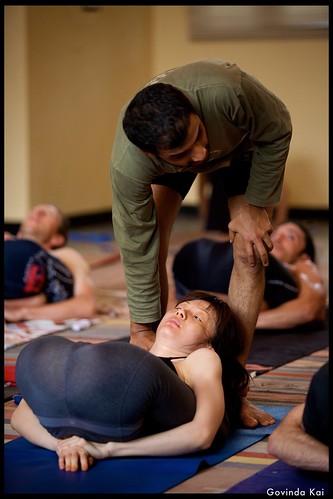
This week we're adding two new classes: Mysore on Tuesday and Thursday nights, 6-730p. As you probably already know, Mysore class is named after the Indian city of Mysore where Ashtanga Vinyasa yoga was born, or at least rediscovered for the modern age, depending on your source.
Anyway, in Mysore class students practice just as they do at the Ashtanga Yoga Research Institute in India (sans coconuts and Delhi belly): supervised self-practice. You show up, roll out your mat, and begin, moving through as much of the Primary Series as you can remember. Instructors wander and give adjustments or prompts for one or two postures beyond what you already know - just enough that you'll remember the new stuff next time. Pretty quickly, it's committed to mental memory and, shortly after that, muscle memory. Then the process of refinement and moving meditation can really begin.
It may seem odd that we would offer a class that teaches you how to practice on your own - like we're teaching ourselves right out of a job, right? Well, maybe so. Or maybe not. Check out this article by a once-hesitant student. Here are our own top ten reasons you should come to Mysore class:
1. You can tell all of your yoga-hype friends. They probably won't know what it is, but it will sound profoundly cool, so they'll just nod.
2. Self-sufficiency. There are two things about self-practice that are difficult to communicate verbally. First, it's really only AFTER you've committed the gross movements to memory - both each posture as well as how to get in and out of them - that the potential of practice starts to open up. Beyond THINKING about the postures, the depth of experience is accessible. Second, when you know what comes next and how to do it you just feel...different. How? Hmmmm...mostly like a f*$%in' yoga-ninja bada$$.
3. Does class seem too fast or too slow sometimes? In Mysore class you can set your own pace. (Disclaimer: this does not include 60 minutes of "take rest" at the end. Let's keep it moving, people.)
4. Silence. No instructor yakkety-yakkin' in some faux-Indian accent. It's just the dragon-lair/bellows rhythm of students moving and breathing.

5. One-to-one instructor attention. In a led class, everyone is doing the same thing at the same time, so the instructor can adjust, at most, one or two people in any given posture (not to mention that fact that he/she is trying to talk and count - in another language, mind you - the whole time). Because of the own-pace of Mysore class, the instructor is (mostly) able to adjust each person in each posture required: binds in the Marichyasana and Kurmasana postures, getting the arms through in Garbha Pindasana, etc. You can learn about and improve on difficult postures much faster getting consistent adjustments.
6. Backbending. There is an aspect of traditional Ashtanga practice that involves assisted backbending, teaching drop-backs and other great party tricks. It's not possible to do this in a led class, but it is an essential part of Mysore.
7. It's a moveable feast: you learn the sequence in class and then those times when you can't come to class you know just what to do...
8. The Good News: above and beyond the Primary Series, there are five more series of postures. Mysore class is the way to eventually move into these series, with the instructor "giving" you one posture at a time to tack on the end of your existing practice.
9. The Bad News: there are five more series. If you come to Mysore class, the instructor might give you some more postures.
10. Inner peace: BAM!
We'll see you there...
(thanks to AshtangaNews.com and Govinda Kai - the instructor adjusting Paschimattanasana above - for the pics)

1 comment:
Post a Comment